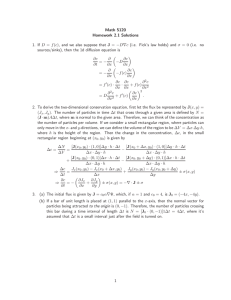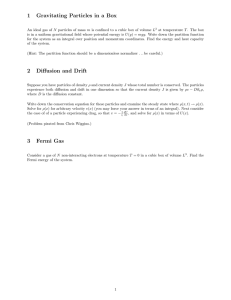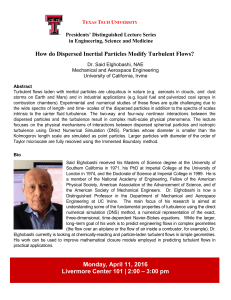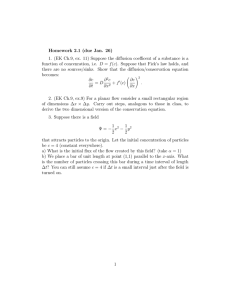EXPERIMENTAL DETECTION OF THE NEW PHENOMENON OF TURBULENT THERMAL DIFFUSION Alexander Eidelman
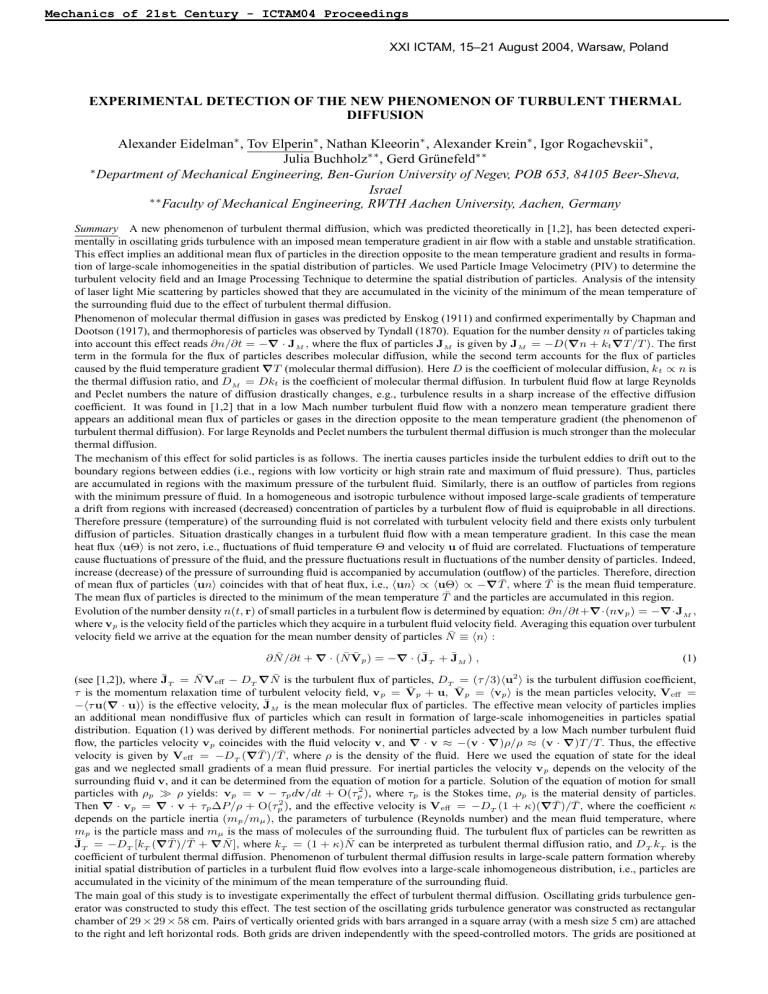
Mechanics of 21st Century - ICTAM04 Proceedings
XXI ICTAM, 15–21 August 2004, Warsaw, Poland
EXPERIMENTAL DETECTION OF THE NEW PHENOMENON OF TURBULENT THERMAL
DIFFUSION
Alexander Eidelman
∗
, Tov Elperin
∗
, Nathan Kleeorin
∗
, Alexander Krein
∗
, Igor Rogachevskii
∗
,
Julia Buchholz
∗∗
, Gerd Grünefeld
∗∗
∗
Department of Mechanical Engineering, Ben-Gurion University of Negev, POB 653, 84105 Beer-Sheva,
Israel
∗∗
Faculty of Mechanical Engineering, RWTH Aachen University, Aachen, Germany
Summary A new phenomenon of turbulent thermal diffusion, which was predicted theoretically in [1,2], has been detected experimentally in oscillating grids turbulence with an imposed mean temperature gradient in air flow with a stable and unstable stratification.
This effect implies an additional mean flux of particles in the direction opposite to the mean temperature gradient and results in formation of large-scale inhomogeneities in the spatial distribution of particles. We used Particle Image Velocimetry (PIV) to determine the turbulent velocity field and an Image Processing Technique to determine the spatial distribution of particles. Analysis of the intensity of laser light Mie scattering by particles showed that they are accumulated in the vicinity of the minimum of the mean temperature of the surrounding fluid due to the effect of turbulent thermal diffusion.
Phenomenon of molecular thermal diffusion in gases was predicted by Enskog (1911) and confirmed experimentally by Chapman and
Dootson (1917), and thermophoresis of particles was observed by Tyndall (1870). Equation for the number density n of particles taking into account this effect reads ∂n/∂t = − ∇ · J
M
, where the flux of particles J
M is given by J
M
= − D ( ∇ n + k t
∇ T /T ) .
The first term in the formula for the flux of particles describes molecular diffusion, while the second term accounts for the flux of particles caused by the fluid temperature gradient ∇ T (molecular thermal diffusion). Here D is the coefficient of molecular diffusion, k t
∝ n is the thermal diffusion ratio, and D
M
= Dk t is the coefficient of molecular thermal diffusion. In turbulent fluid flow at large Reynolds and Peclet numbers the nature of diffusion drastically changes, e.g., turbulence results in a sharp increase of the effective diffusion coefficient. It was found in [1,2] that in a low Mach number turbulent fluid flow with a nonzero mean temperature gradient there appears an additional mean flux of particles or gases in the direction opposite to the mean temperature gradient (the phenomenon of turbulent thermal diffusion). For large Reynolds and Peclet numbers the turbulent thermal diffusion is much stronger than the molecular thermal diffusion.
The mechanism of this effect for solid particles is as follows. The inertia causes particles inside the turbulent eddies to drift out to the boundary regions between eddies (i.e., regions with low vorticity or high strain rate and maximum of fluid pressure). Thus, particles are accumulated in regions with the maximum pressure of the turbulent fluid. Similarly, there is an outflow of particles from regions with the minimum pressure of fluid. In a homogeneous and isotropic turbulence without imposed large-scale gradients of temperature a drift from regions with increased (decreased) concentration of particles by a turbulent flow of fluid is equiprobable in all directions.
Therefore pressure (temperature) of the surrounding fluid is not correlated with turbulent velocity field and there exists only turbulent diffusion of particles. Situation drastically changes in a turbulent fluid flow with a mean temperature gradient. In this case the mean heat flux h u Θ i is not zero, i.e., fluctuations of fluid temperature Θ and velocity u of fluid are correlated. Fluctuations of temperature cause fluctuations of pressure of the fluid, and the pressure fluctuations result in fluctuations of the number density of particles. Indeed, increase (decrease) of the pressure of surrounding fluid is accompanied by accumulation (outflow) of the particles. Therefore, direction of mean flux of particles h u n i coincides with that of heat flux, i.e., h u n i ∝ h u Θ i ∝ − ∇
The mean flux of particles is directed to the minimum of the mean temperature T
T , where
¯ is the mean fluid temperature.
and the particles are accumulated in this region.
Evolution of the number density n ( t, r ) of small particles in a turbulent flow is determined by equation: ∂n/∂t + ∇ · ( n v p
) = − ∇ · J
M where v p is the velocity field of the particles which they acquire in a turbulent fluid velocity field. Averaging this equation over turbulent velocity field we arrive at the equation for the mean number density of particles N ≡ h n i :
,
∂
¯
+ ∇ · N V p
) = − ∇ · (¯
T
J
M
) , (1)
(see [1,2]), where
τ is the momentum relaxation time of turbulent velocity field, v
−h τ u ( ∇ · u ) i
J
T
= ¯ V eff
− D
T is the effective velocity,
∇
¯
J
M is the turbulent flux of particles, p
V p
D
+ u ,
T
= (
V p
τ /
= h
3) v h p u i
2 i is the turbulent diffusion coefficient, is the mean particles velocity, V eff
= is the mean molecular flux of particles. The effective mean velocity of particles implies an additional mean nondiffusive flux of particles which can result in formation of large-scale inhomogeneities in particles spatial distribution. Equation (1) was derived by different methods. For noninertial particles advected by a low Mach number turbulent fluid flow, the particles velocity velocity is given by V eff v
= p coincides with the fluid velocity v , and ∇ · v ≈ − ( v · ∇ ) ρ/ρ ≈ ( v · ∇ ) T /T.
Thus, the effective
− D
T
( ∇ T ) /
¯ where ρ is the density of the fluid. Here we used the equation of state for the ideal gas and we neglected small gradients of a mean fluid pressure. For inertial particles the velocity v p depends on the velocity of the surrounding fluid v , and it can be determined from the equation of motion for a particle. Solution of the equation of motion for small particles with
Then ∇ · v p
ρ
= p
∇ ·
ρ v yields:
+ τ p
∆ v p
P/ρ
= v − τ p
+ O( τ 2 p d v /dt + O( τ p
2 depends on the particle inertia ( m p
/m
µ
) , where τ p is the Stokes time,
) , and the effective velocity is V eff
= − D
T
ρ p is the material density of particles.
(1 + κ )( ∇
¯
) /
¯ where the coefficient κ
) , the parameters of turbulence (Reynolds number) and the mean fluid temperature, where m
J
T p is the particle mass and m
µ
= − D
T
[ k
T
( ∇
¯
) /
¯
+ ∇
¯ is the mass of molecules of the surrounding fluid. The turbulent flux of particles can be rewritten as
] , where k
T
= (1 + κ ) ¯ can be interpreted as turbulent thermal diffusion ratio, and D
T k
T is the coefficient of turbulent thermal diffusion. Phenomenon of turbulent thermal diffusion results in large-scale pattern formation whereby initial spatial distribution of particles in a turbulent fluid flow evolves into a large-scale inhomogeneous distribution, i.e., particles are accumulated in the vicinity of the minimum of the mean temperature of the surrounding fluid.
The main goal of this study is to investigate experimentally the effect of turbulent thermal diffusion. Oscillating grids turbulence generator was constructed to study this effect. The test section of the oscillating grids turbulence generator was constructed as rectangular chamber of 29 × 29 × 58 cm. Pairs of vertically oriented grids with bars arranged in a square array (with a mesh size 5 cm) are attached to the right and left horizontal rods. Both grids are driven independently with the speed-controlled motors. The grids are positioned at
Mechanics of 21st Century - ICTAM04 Proceedings
N r
1
0.98
0.96
0.94
0.92
0.9
0.88
0 0.02
0.04
0.06
T r
Figure 1. Normalized particles number density N r turbulent non-isothermal flow.
≡ N /
¯
0 versus normalized temperature difference T r
≡ ( ¯ −
¯
0
) /
¯
0 in the a distance of two grid meshes from the chamber walls parallel to them. This two-grid system is capable of oscillating at controllable frequency up to 20 Hz. The grid stroke was adjusted in a range 6 − 10 cm.
A mean temperature gradient in the turbulent flow with a stable and unstable stratification was formed with two heat exchangers.
Temperature measurements were conducted in the oscillating grids turbulence generator. The temperature difference between the heat exchangers varied in the range from 25 up to 50 K. In order to improve heat transfer in the boundary layers at the walls we used heat exchangers with the rectangular fins which allowed us to support a mean temperature gradient in the core of the flow up to 200 K/m at a mean temperature of about 300 K. We determined the mean and r.m.s. velocities, two-point correlation functions and an integral scale of turbulence from the measured velocity fields. Turbulent flow parameters in the oscillating grids turbulence generator are as follows: the Kolmogorov’s length scale η is about 0 .
4 mm, the Taylor’s scale is about 5 mm, and the integral scale of turbulence is 15 mm (the vertical size of the chamber is 30 cm). The spatial resolution of the conducted PIV measurements was about 5 η.
The measured r.m.s.
velocity was several times higher than the characteristic mean velocity in the core of the flow.
The effect of Mie light scattering by particles was used to determine the particles spatial distribution in the flow. The scattered light energy flux incident at the CCD camera probe is proportional to the particles mean number density. Analysis of the intensity of laser light Mie scattering by particles in non-isothermal turbulent fluid flows demonstrated that particles are redistributed in the vertical direction in the chamber, they are accumulated in the regions with the minimum mean temperature. The dependence of the normalized particles number density N r
≡ is the reference temperature and
N /
¯
0
¯
0 versus the normalized temperature difference T
N ( ¯ T
0
) .
r
≡ ( ¯ − T
0
) /
¯
0
, is shown in Fig. 1, where T
0
Figure 1 corresponds to the case of the stable stratification (i.e., for the experiments in the chamber with the cooled bottom wall and heated top wall of the test section).
In order to explain the dependence N
¯
V eff fluid velocity
¯ r versus T r shown in Fig. 1 consider Eqs. (1). If one does not take into account the term in Eq. (1) for the mean number density of particles, this equation reads ∂ N /∂t = D
T
∆ ¯ where we neglected a small mean solution of this equation is isothermal turbulent flow, i.e., when
N V eff
V p and small molecular mean flux of particles (that corresponds to the conditions in our experiment). The steady-state
¯ in Eq. (1). Now the steady-state solution of this equation for the non-inertial particles reads:
N /
¯
0
= 1 − T − T
0
) /
¯
0
,
N = where const. However, our measurements demonstrate that the solution
¯
T
−
=
¯
0
¯
= const is valid only for the const. Let us take into account the effect of turbulent thermal diffusion, i.e., include the term
¯
0
.
In our experiments we found that N /
¯
0
= 1 − α
∇
( ¯
N /
−
¯
0
¯
= − ∇
) /
¯
0
,
T /
¯
This yields where the coefficient
α = 1 .
71 , i.e., α > 1 .
The deviation of the coefficient α from 1 is caused by a small yet finite inertia of the particles. In all experiments performed for different ranges of parameters and different initial conditions, α was more than 1 in agreement with the theory, which predicts α = 1 for the noninertial particles, and α > 1 for inertial particles. These experiments were performed for different Reynolds numbers (based on the integral scale of turbulence and r.m.s. velocity) in the range from 150 to 300, and small particles mass loadings.
However, the dependence of the parameter α on the Reynolds number in this range is weak. The number density of particles in these experiments was of the order of 10 10 particles per m
3
, so that their collision rate is negligibly small. The effect of the gravitational settling of small particles ( 0 .
5 − 1 µ m) is negligibly small since the terminal fall velocity of these particles is less than 0 .
01 cm/s.
In the case of unstable stratification (the heated bottom wall and cooled top wall of the test section) particles are accumulated in the vicinity of the top wall of the chamber due to the effect of turbulent thermal diffusion. It was also found that the turbulent thermal diffusion coefficient was larger than that for the turbulent flow with a stable stratification. Note that the total variation of the normalized particles number density due to the effect of turbulent thermal diffusion is more than 10% , and the accuracy of our measurements is less than 0 .
3% , that is high enough to detect this effect. The obtained experimental results are in a good quantitative agreement with the theoretical predictions [1,2]. Thus, these experiments confirmed the existence of the effect of turbulent thermal diffusion.
References
[1] Elperin T., Kleeorin N. and Rogachevskii I.: Turbulent Thermal Diffision of Small Inertial Particles. Phys. Rev. Lett. 76: 224–227, 1996.
[2] Elperin T., Kleeorin N. and Rogachevskii I.: Turbulent Barodiffusion, Turbulent Thermal Diffusion and Large-Scale Instability in Gases. Phys.
Rev. E 55, 2713–2721, 1997.


